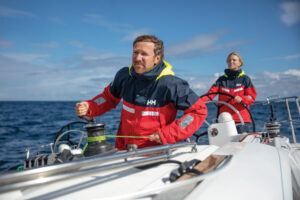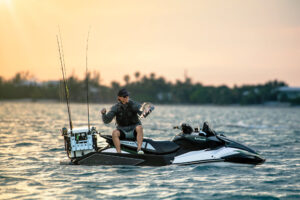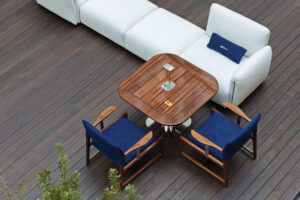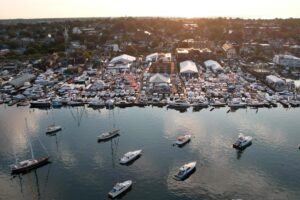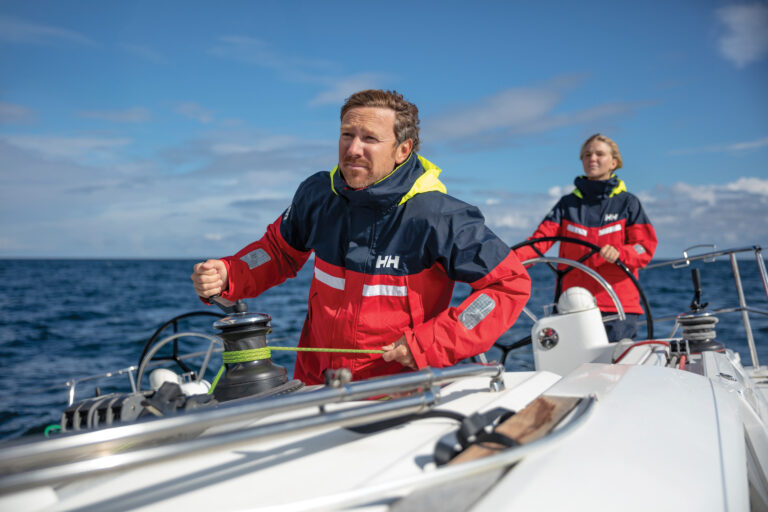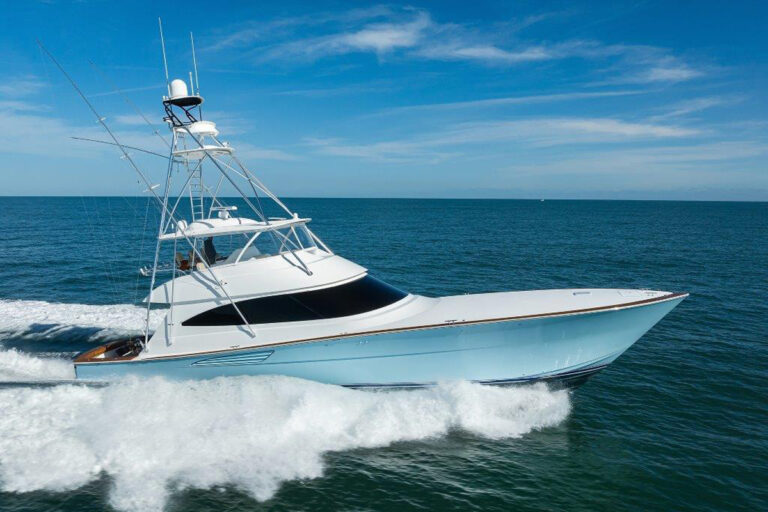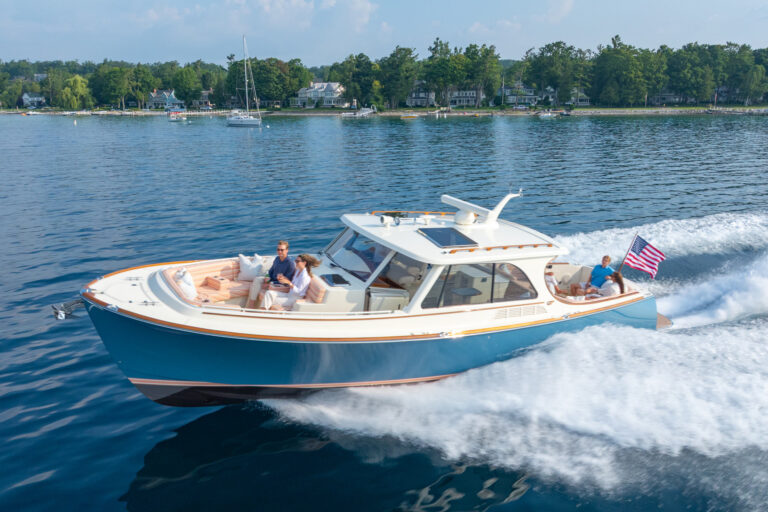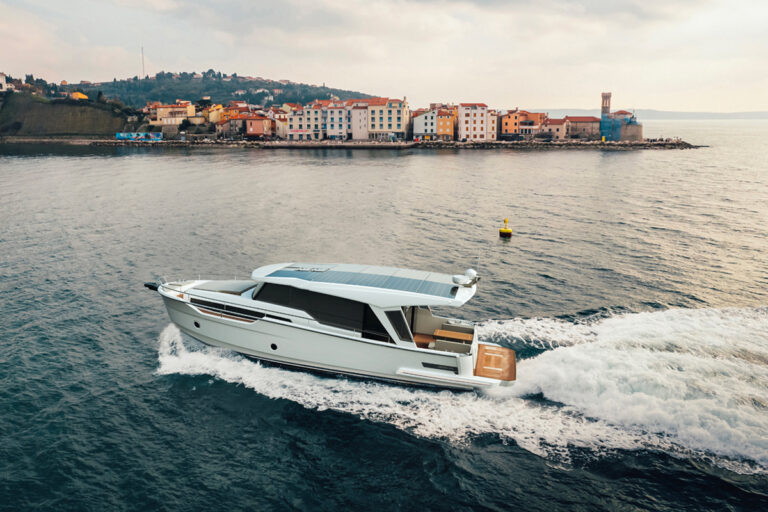
Lightning
The first Tag 60 ever built is innovative in almost every way. Designed by New Zealander Greg Young and built by Tag Yachts of South Africa, (www.tagyachts.com) this catamaran is all carbon fiber, which makes it essential that she have the most advanced lightning protection system possible. Insurance statistics show that a cruising catamaran is twice as likely to be struck by lightning as a monohull sailboat and 45 times more likely than a motoryacht. Claims due to a strike are also higher, reflecting greater damage.
Ewen Thomson, one of America’s leading experts on lightning and boats, says it’s all about footprint. Multihulls are wider so they enjoy less shielding from nearby boats when they are at a marina. Because of their beam, they are also more likely to be tied to a face dock, in which case they have no shielding at all on the open-water side.
Even though motoryachts are far less likely to be struck, new technology works against owners of these boats as well. A lightning strike may disable the ECU of a modern electronically controlled diesel engine. Old-style mechanical diesels will continue to chug along even if disconnected from the ship’s batteries. This makes them less likely to be affected by a direct hit, which would shut down a new boat.
Pod-drives from Volvo Penta and Cummins are a hot commodity, but the threat of damage from lightning is twofold. Not only is thrust controlled electronically, but steering is also. “You can undoubtedly appreciate the vulnerabilities that arise when electric control lines converge from all over the boat onto the best immersed ground on the vessel,” Thomson says, referring to the pod-drives.
Given the reputation of the manufacturers, these electronic controls are probably about as robust as they can possibly be, but consider what might confront them on any given summer day. Though it lasts only a fraction of a second, a lightning strike can develop millions of volts, peak currents of tens of thousands of amps and temperatures of up to 50,000 degrees F.
The marine industry’s long-standing lightning protection language urges boatbuilders to put a one-square-foot grounding plate along the keel, connected to the mast, arch or other part high in the structure with heavy-gauge wire and to the ship’s bonded underwater metal fittings. Thomson says his research contradicts that wisdom.
During his tenure as a researcher and associate professor at the University of Florida in Gainesville, Thomson authored several influential papers on lightning physics, including lightning in a marine environment. He collaborated with other experts in writing standards for the American Boat and Yacht Council and National Fire Protection Association. In 2001, he left academia to found Marine Lightning Protection Inc. His company developed a system — and patented some of its unique equipment — that Thomson and a growing number of marine industry people believe can save lives and make marine electronics less likely to be ruined by a strike.
Thomson’s system works by creating, in effect, a Faraday cage around the boat and its occupants. This invention is named after Michael Faraday, who in 1836 discovered that an enclosure of conducting materials shielded its contents from electrical effects and could be used to protect against lightning.
Starting from the top of a fiberglass (or carbon fiber) vessel, Thomson’s system uses one or more air terminals (lightning rods) attached to other system components with heavy-gauge cable. Thomson looks for existing metal structures, such as a Bimini frame and deck rails on a powerboat or the metal bow and stern pulpits or toe rails on sailboats. In the ideal scenario, these structural conductors are as far outboard as possible and make at least one circuit around the outside of the boat. They are then bonded to a series of Siedarcs, electrodes made of copper rod, honed to a point and potted with epoxy in a through-hull fitting, installed at intervals just above the waterline.
Thomson developed the Siedarc after years of forensic examination of lightning-struck boats showed that the area above the waterline was frequently hit by side flashes — high-voltage sparks that cause damage, injury and possibly death. Thomson’s system calls for at least two grounding strips beneath the water rather than a traditional metal plate. He urges that these grounding strips be attached high on the hull, closer to the waterline than the keel, but he thinks these hunks of metal play a less important role than previously believed.
“The idea behind the ground plate has been that it somehow conducts current into the water and then down to China — that’s been the concept,” Thomson says, launching into an analogy. “On a battery you have a plus terminal and a negative terminal. Hook a wire up to the positive and a wire to the negative and put something like a light in the middle. Charges flow from the battery through the light, give it energy and then go back to the battery again. That’s an electric circuit. Lightning, when it hits the boat, is effectively a wire to the charge in the clouds, through the boat to the water. But what’s the return path from the water to the cloud to make a complete electric circuit? It makes a huge difference when you realize that this circuit is not going to China; it’s not even going into the ground. The current goes back into the sky, but the way it gets there is from a charge on the surface of the water.”
Trying to force this massive charge out through a ground plate at the bottom of the vessel is a bad idea because water is a medium that impedes the process, like impedance in an electrical circuit.
Thomson argues that conventional notions about grounding plates are ineffective and potentially dangerous. Routing lightning through the interior of a vessel to a plate near a mast step can force a charge to build up at the center of the boat and cause the side flashes that threaten the crew and electronic gear.
The National Fire Protection Association worked closely with Thomson to incorporate his principles in its 2008 standards for watercraft safety. NFPA recognized that his system is similar to lightning protection on a building, channeling the charge to ground along the exterior, rather than the interior, of a vessel.
Ewen Thomson and his ideas have proved troubling to the American Boat and Yacht Council (ABYC). It has balked at following the lead of the NFPA, some members of which have argued that ABYC’s long-standing lightning protection standard, which includes the centralized ground plate, should be eliminated from its catalog altogether. Instead, the ABYC in 2006 downgraded its lightning protection “standard” to a “technical paper,” intended to carry less weight among boatbuilders. At the same time, some of the language was modified to accommodate Thomson’s new ideas, but without specifically recommending or even explaining his Siedarc technology.
The ABYC’s lukewarm endorsement has not stopped a growing cadre of yacht designers from recommending Thomson’s system. Since the first installation, more than 30 vessels have received the Siedarc system, including a Great Harbour 37, a Nordhavn 55, a Nordhavn 62, the circumnavigating 60-foot power-cat Domino II and a 140-foot catamaran to be finished at the Pendennis Shipyard in the United Kingdom.
Thomson’s system is standard for Tags. “We put a lot of faith in Ewen’s research and designs and are happy to promote his work …” Young says.
As this article was being written, that first Tag 60 was scheduled to sail from South Africa to the electric atmosphere of Florida.
Marine Lightning Protection Inc., 352-373-3485; www.marinelightning.com

